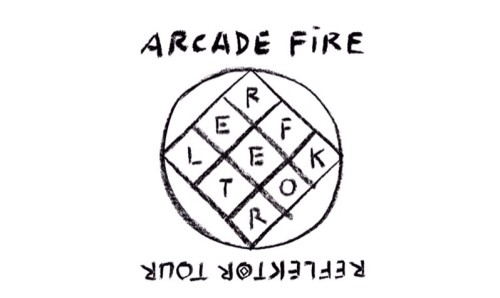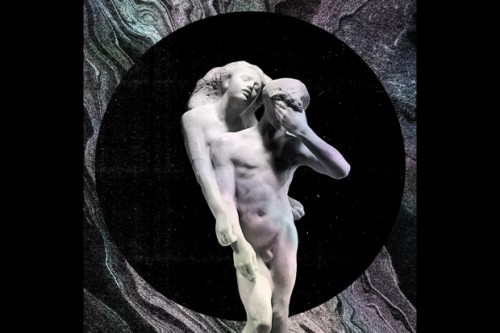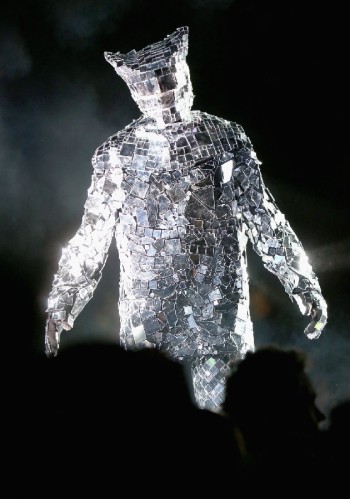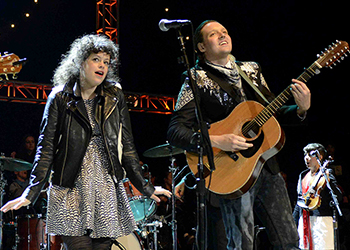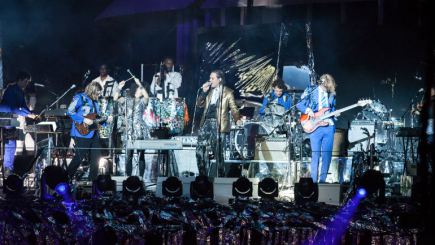Arcade Fire grew to prominence as an indie-band, releasing the critically acclaimed Funeral in late 2004. Since then, they’ve released Neon Bible (2007), Grammy Award-winning The Suburbs (2010), and, most recently, the double album Reflektor (2013). This year, they’ve embarked upon a gargantuan arena tour, recently playing two nights at Chicago’s United Center on August 26th and 27th. Alex and I were lucky enough to find cheap tickets, and attended the concert in all of its stadium-esque glory.
Exiting the arena after the concert, we both remarked how strange it was for us to see a band playing an arena tour at the height of their powers — more remarkable for how unusual Arcade Fire is in its conception. Usually, such shows are the providence of aging boomer-rock bands like the Rolling Stones, Bruce Springsteen, or any major act of the ’70s or ’80s that’s still going strong (looking at you, U2). Arcade Fire’s success is most deserved, yet remarkably bizarre. Their act isn’t just driving guitar rock, nor is it a part of the modern folk revival — instead, it’s a combination of soaring anthems, intricate chamber music, and deeply intimate musings about issues ranging from life and death to suburban malaise, from external perception to internal actualization. And they’re Canadian, to boot. They’re a weird fucking group.
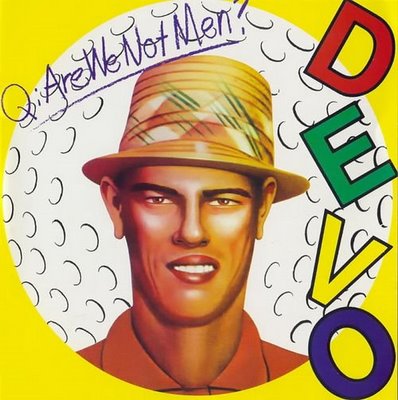 (Although not as weird as Devo. Neither Alex nor I had any idea that the opening act would be the New Wave/punk hybrid that is Devo. If you had told me at the turn of the year that I would see the band that created “Whip It” live in concert in an arena, I would have laughed you out of the room. Devo were certainly good, though I feel that chemical manipulation of a higher order than a stadium-sized Goose Island Green Line would have aided and abetted my enjoyment of their act.)
(Although not as weird as Devo. Neither Alex nor I had any idea that the opening act would be the New Wave/punk hybrid that is Devo. If you had told me at the turn of the year that I would see the band that created “Whip It” live in concert in an arena, I would have laughed you out of the room. Devo were certainly good, though I feel that chemical manipulation of a higher order than a stadium-sized Goose Island Green Line would have aided and abetted my enjoyment of their act.)
An important element of the concert of which Alex and I weren’t aware of (in addition to the devious Devo) was the request for formal concert attire by the band. What one might call a “hipster request,” the band had asked everyone to dress up, as though to class up the event, or to call attention to the quality of the night’s proceedings. I don’t know if banana costumes and pig masks were what they had in mind, but those outfits certainly happened. At the same time, there were more Carnivale masques and peacock feathers than I had seen in one location since Pride Parade back in June. The result was a flamboyant spectacle, a dedicated outpouring of love and affection towards this collective of musicians from Montreal, and what might be considered an attempt to dress down the overwhelming size of the arena by dressing as though they were playing an intimately small club buried in the North Side.
In fact, one of the reasons I love Arcade Fire is their sense of intimacy and musical interplay. Songs on Funeral such as “Une Annee Sans Lumiere” could almost be described as chamber music, probably better served at a venue like Thalia Hall. At the same time, I love that they can play as bombastically as any hard rock band, with tracks like “Keep the Car Running” from Neon Bible creating an almost Springsteen-esque vibe. I was worried that the United Center would play heavily towards their latter tendencies while abandoning the former entirely.
The start of their set seemed to validate my concerns, as what can only be described as a six-foot troll which had been rolled in shards of a hundred disco balls (Alex’s response: “Shiny!… shiny…”) walked out to an elevated platform and introduced the band as spotlights induced a thousand seizures by radiating off its body. The band opened with “Reflektor,” the title track from their new album: a pounding, repetitive ode to discovery of identity through death. (Lead singer/songwriter Win Butler has listed as influences for their latest record the 1957 film Black Orpheus and Kierkegaard. This ain’t no Taylor Swift shallow pop we’re talking about here.) They then transformed into “Neighborhood #3 (Power Out)” from their first album, amping their performance up to a frenetic pace that had the entire pit in front of the stage shaking and tremulating with fervent desire.
Arcade Fire has a tremendous amount of musicians, so much so that the stage appears overtly cluttered at time. It’s hard to keep twelve musicians on stage at one time. (I refuse to count Disco-Troll as a band member.) To wit, they had:
- Win Butler, singing, playing keyboards and guitars
- His wife, the French-Canadian-Haitian singer Regine Chassagne
- Another guitar player
- A bass player
- A keyboard player
- A synthesizer devotee
- A drummer
- Two saxaphones
- A violinist
- Two additional percussionists
All in the name of rock, I suppose.
Their stage design could be interpreted as “efficient decadence.” Two screens were set up on either side of the stage, each consisting of four interlocked mirrors; these would show images of band members performing, inverted (or refleKted!) and flanking the musicians onstage. Six-sided mirrors hung suspended over the stage, adding further refleKtions to the proceedings at hand. At times, a giant scaffold supporting a disco ball would lower over the audience, projecting cascades of light across the audience. A giant screen behind the band was used to remarkable effect during one song where Chassagne mounted the raised platform in the center of the pit, surrounded by ghostly skeleton dancers as she sang across the void to Win. Knowing that the pair are husband and wife adds to the existential despair felt by seeing Win watch as his wife is consumed by grotesque, digitally manipulated manifestations of death.
Musically, the band drew heavily from Reflektor and Funeral — while they’re touring in support of their new record, the band knows what has made their reputation. Anytime something like “Neighborhod #1 (Tunnels)” played, the United Center turned into a massive singalong hall. There were multiple selections from Suburbs, and only two from Neon Bible. Butler only addressed the crowd on a few occasions, thanking the audience for attending before playing “The Suburbs” and lambasting America’s reluctant acceptance of gay marriage before plunging into “We Exist.” As a frontman, Butler can certainly be magnetic, alternating between a tortured Cobain-esque appearance and a gleeful, exuberant kid who gets to play music for a living.
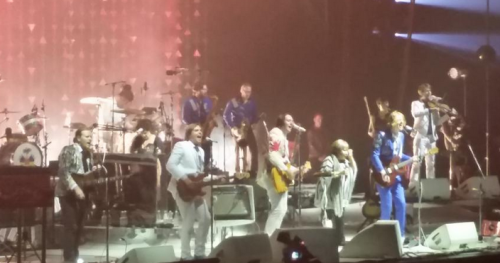
All apologies for the poor quality of the image. Mavis Staples is standing next to Win Butler — she’s the short one.
The latter sentiment was certainly in evidence for the band’s encore, which opened with a surprise guest appearance. As the band returned to the stage, they were joined by legendary soul singer Mavis Staples, a woman whom Bob Dylan once considered marrying. She lead the band in a rousing cover of the Rolling Stones “The Last Time,” one where her voice radiated with all the Biblical power of the Gospel. It was impossible not to see Butler smiling gleefully as Chassagne danced around in all of her nymph-like joy. Say what you will about Arcade’s Fire music, but it is impossible to watch them and not see how much they all love playing together. As dark as their lyrics may be, they are all consummate musicians, with intricate understandings of each other’s rhythms, styles, and tendencies. As an erstwhile musician myself, I will vouch for how rare it is for a band to be as in sync with each other as they are.
Their final song, the anthemic “Wake Up,” confirmed what everyone in the audience already knew — this is a band that will last. Bands spend their entire careers trying to write a song that will stand the test of time, maybe push a few records, and leave their legacy in gold-plated records. Arcade Fire did that on their first record, writing a song that speaks to an entire generation. Take a look at the second verse:
Children, wake up!
Hold your mistake up
Before they turn the summer into dust
If the children don’t grow up
Our bodies get bigger but our hearts get torn up
We’re just a million little gods causing rain storms
Turning every good thing to rust
I guess we’ll just have to adjust.
The soaring chorus was sung by the entire building (yours truly included), and was a moment where the band drops out to let the audience take the lead. Normally, this is something only Bruce Springsteen can get away with. Today, Arcade Fire are the new E Street Band. This is the rallying cry of a million hearts that broke at the start of the century. We all just have to adjust.
(Arcade Fire’s Reflektor Tour concluded August 30th in their hometown of Montreal. Stay tuned for future touring updates at the band’s official website.)

